When discussing the future of the energy industry, the topics of conversation mirror a radio playlist set on repeat. They include fossil fuels, described as the industry’s bad boy with a limited shelf life, while wind and solar gain more real estate and are looked upon as the future of clean energy production. Geothermal energy goes largely unnoticed by the public, although great strides have been made in technological advancement and an influx of opportunity as its benefits become more apparent daily.
Geothermal energy influences various sectors, from electricity production to heating and cooling systems, positioning itself as a critical player in the green energy revolution. While this energy source offers a reduced carbon footprint and long-term cost-effectiveness, process advancements have made it increasingly accessible and efficient.
GreenFire Energy is a regular in the geothermal energy space to ensure the long-term availability of resilient, sustainable and scalable geothermal energy for a wide array of uses. GreenFire’s technology can be applied to maximize the economic production of underperforming existing geothermal wells and new greenfield projects.

Mirroring Oil and Gas
Geothermal energy is a form of thermal energy extracted from the Earth’s crust and has been utilized for thousands of years. The more popular uses are known to include cooking and fueling heating systems. The thermal areas of the Earth’s surface yield temperature gradients exceeding 40 degrees Celsius per kilometer of depth. Within these areas, thermal fields exist where subsurface permeability allows fluid to convey deep-seated heat to the surface. Geothermal field classification is based on the fluids produced at the surface of the Earth.
According to Rob Klenner, president of GreenFire Energy, geothermal energy offers a viable renewable energy source that surpasses the more mainstream solutions like wind and solar power. However, its mirroring of oil and gas makes it an interesting concept that can be used as a clean energy solution.
“Geothermal energy production is very akin to what the oil and gas industry does with drilling wells and producing fluid,” says Klenner. “Over time, pressure declines, which leads to a decline in production. Typically, water can be injected to stimulate production, but new recovery techniques are now available.”
Klenner adds, “That is where the GreenFire downhole heat exchanger comes into play. It can be installed in idle wellbores and circulate heat in a closed-loop system, allowing us to revitalize these wells.”
According to Klenner, the United States leads geothermal production globally for two purposes: power generation and electricity. Major power plants are found in California, Nevada, Utah, Hawaii, Oregon and New Mexico, with other projects underway across the country. As technological advancement continues to increase within the geothermal production world, the footprint is expected to grow.
Starts in the Wellbore
Geothermal energy starts with a well. A well is drilled to a certain depth to capture the heat of the ideal or desired temperature. The process is similar to that of drilling an oil or gas well. This proves to be a viable solution where available real estate can be located, but geothermal pioneers acting in continuation of research and development have devised an additional solution in harnessing heat from within the Earth.
With a push across the board to reduce expenditures, save money, and work with existing infrastructure, existing geothermal or oil and gas wells of a mature state can serve as a portal into the Earth for that desired heat. This serves as a viable alternative to drilling new wells while also offering a solution to orphaned or abandoned wells that leach dangerous methane emissions into the atmosphere.
“While the majority of our projects are with existing geothermal producers, we have the opportunity and technology that works well with many oil and gas companies,” says Klenner. “The industry has done geothermal well while capitalizing on the cost-cutting factor.”
In either solution of new or existing wellbores, freshwater or other working fluids extract the heat during a closed-loop circulation. Klenner says the closed-loop solution allows GreenFire to run fluids at increased speeds if needed to achieve the desired temperature goal.
“Different engineered geothermal techniques can be used for specific reservoirs and end use.”
Geothermal Energy Types
Geothermal resources are classified based on their temperature and depth:
- Shallow geothermal energy (30 to 400 meters): This is the most widespread form of geothermal energy in some countries. It uses the constant temperature of the Earth just below the surface, typically between 12° and 15° Celsius. This energy is often used with heat pumps to heat and cool buildings.
- Deep geothermal energy (from 400 meters depth): In some geological formations, water between one and four kilometers deep can reach between 40° and 130° Celsius. Depending on the temperature, this energy can be used for district heating or electricity production.
- Geothermal energy of great depth (from 4,000 to 6,000 meters): Rock temperatures can reach 200° Celsius at these depths. This high-temperature resource can be used for both electricity production and heating.
Geothermal resources are also classified as low, intermediate or high enthalpy resources, according to their reservoir temperatures. However, temperature alone is not always a suitable classification parameter, as the specific enthalpy and exergy of the geothermal fluid can vary significantly even at the same temperature.
Geothermal energy influences various sectors from electricity production to heating and cooling systems. It is a promising solution for sustainable power generation, offering a clean and reliable alternative to fossil fuels. As geothermal technology advances, it is expected to play an increasingly crucial role in our sustainable energy future.
 Electricity Generation
Electricity Generation
Geothermal power plants harness heat from beneath the Earth’s surface to produce electricity. They are constructed near geothermal reservoirs where the hot water or steam is extracted from underground activity.
Geothermal power plants come in three distinct types or designs. Dry steam plants utilize steam extracted from underground reservoirs to drive or power turbines. According to Klenner, the geysers located in northern California are one of the largest sources of geothermal electricity and produce nearly 835 megawatts today. One of GreenFire’s main projects is working there to improve geothermal production in an existing well.
Flash steam plants are typically the more popular power plant solution. High-temperature water is directed from underground and, as it rises, the pressure decreases. As a result, some of the water flashes to steam and is used to drive turbines.
Binary cycle plants can utilize lower-temperature geothermal resources, enabling increased location selection. These systems use low boiling point secondary fluids heated by geothermal water. The vapor produced from this practice then drives turbines for power generation.
Direct Use Applications
Geothermal energy is highly effective for heating and cooling buildings, offering an energy-efficient alternative to traditional HVAC systems. Geothermal heat pumps use the Earth’s constant temperature just below the surface to heat and cool buildings. Klenner indicates there is a growing popularity and need across Europe in using geothermal energy for direct heat use for heating and cooling.
These systems work by circulating a fluid through underground pipes, where it absorbs heat from the Earth in winter or releases heat into the ground in summer. The heat pump then concentrates this energy and distributes it throughout the building. This process is highly efficient, with geothermal heat pumps being up to four times more efficient than furnaces or boilers and twice as efficient as air-source heat pumps. They can reduce overall energy consumption in homes and provide both air conditioning in summer and heating in winter.
Geothermal district heating systems can save consumers 30% to 50% of the cost of natural gas heating. They can also be used in various industrial processes, including food dehydration, gold mining, milk pasteurizing and greenhouse heating.
Finding Its Place in the Future
Geothermal energy applications demonstrate their versatility and potential as a clean, renewable resource. As technology advances and becomes more accessible, geothermal energy is poised to play an increasingly vital role in the future of sustainable energy.
According to Klenner, the geothermal solution leads the way in the base land supply of renewable energy with a significant factoring of uptime. It refrains from depending on external and uncontrollable factors. Solar power suffers from cloudy days, and wind turbines fail to turn on calm days. The progress of geothermal energy production is free from those constraints. As a result, its future shows excellent favor.
“Geothermal energy is becoming more mainstream, like wind and solar energy,” says Klenner. “Supplemental technology will accelerate significant growth over the next 10 years, and when looking at 2030 and beyond, I think we’ll see a broader adoption of this application.”
Headline Photo: EDC’s Mahanagdong geothermal field in Leyte, Philippines.
Nick Vaccaro is a freelance writer and photographer. In addition to providing technical writing services, he is an HSE consultant in the oil and gas industry with twelve years of experience. Vaccaro also contributes to SHALE Oil and Gas Business Magazine, American Oil and Gas Investor, Oil and Gas Investor, Energies Magazine and Louisiana Sportsman Magazine. He has a BA in photojournalism from Loyola University and resides in the New Orleans area. Vaccaro can be reached at 985-966-0957 or nav@vaccarogroupllc.com.






